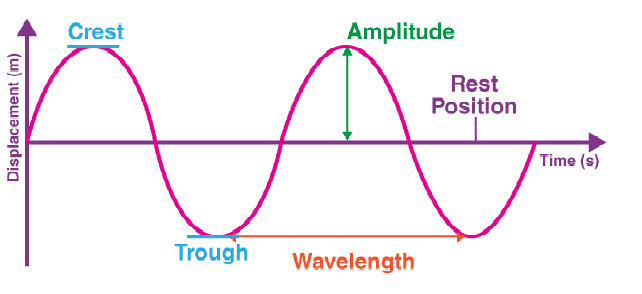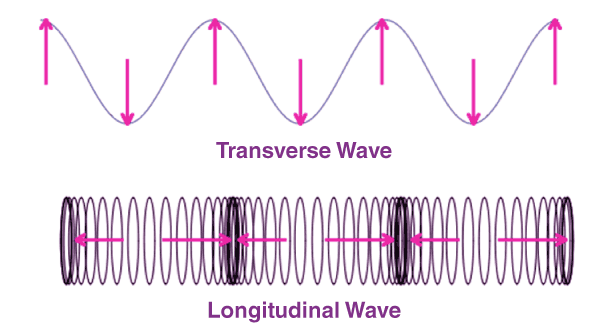- Home/
- SSC & Railways/
- SSC CGL/
- Article
Waves: Definition, Types & Properties of Waves
By BYJU'S Exam Prep
Updated on: September 25th, 2023

Waves is an important topic if you are preparing for any Government Exam and there are nearly 2 to 3 questions asked from this topic in General Science Section. As per the analysis of SSC & Railway Exams previous year question paper, we have unveiled that the questions on topic Types of Waves & their properties are asked in every SSC exam. So, below we have provided the physics notes on the topic Waves, including properties and types of Waves, that one should definitely not miss if he is gearing up to appear in any government exam.
Table of content
What is a Wave?
A wave is a disturbance, which propagates energy from one place to the other without the transportation of matter. A wave transmits information or energy from one point to another in the form of signals, but no material object makes this journey. The frequency of a wave is obtained by including a factor of time in the mix. We are completely dependent on waves for all of our wireless communications.

Types of Waves in Physics
Wave is a propagation of disturbances that passes through a medium in an organized way. There are two types of waves which are longitudinal and transverse. While transverse waves are in which the medium vibrate perpendicular to the direction of propagation of the wave. On the other hand, in longitudinal wave the particles move in the same direction to the wave. Check out the types of waves and their properties below.
- Mechanical wave (longitudinal wave and transverse wave)
- Electromagnetic wave
- Matter Wave
Mechanical Waves
Longitudinal Waves
- In this wave, the particles of the medium vibrate in the direction of propagation of the wave.
- Waves on springs or sound waves in the air are examples of longitudinal waves.
Transverse Waves
- In this wave, the particles of the medium vibrate perpendicular to the direction of propagation of the wave.
- Waves on strings under tension, and waves on the surface of the water are examples of transverse waves.

Electromagnetic Waves
- The waves, which do not require a medium for their propagation i.e., which can propagate even through the vacuum are called electromagnetic waves.
- These waves propagate with the velocity of light in the vacuum.
- Following are the electromagnetic (Non-mechanical) waves-
1. Gama rays (Highest frequency)
2. X-rays
3. UV rays
4. Visible radiation
5. Infra-red rays
6. Short radio waves
7. Long radio waves (Lowest frequency)
All are in decreasing order of frequency. - Following waves are not categorized as electromagnetic.
1. Cathode rays
2. Canal rays
3. Alpha rays
4. Beta rays
5. Sound waves
6. Ultrasonic wave
Following are the different types of Electromagnetic Waves:
- Microwaves
- X-ray
- Radio waves
- Ultraviolet waves
Examples of Electromagnetic Waves:
- Radio and Television
- RADAR
- Microwave Oven etc.
Sound Waves
Sound waves are longitudinal mechanical waves. Based on their frequency range sound waves are divided into following categories.
(a) The sound waves which lie in the frequency range 20 Hz to 20000 Hz are called audible waves.
(b) The sound waves having frequencies less than 20 Hz are called infrasonic
(c) The sound waves having frequencies greater than 20000 Hz are called ultrasonic waves. Ultrasonic waves are used for sending signals, measuring the depth of see, cleaning clothes and machinery parts, remaining lamp short from the chimney of factories and in ultrasonography.
Speed of Sound
- The speed of sound is maximum in solids and minimum in gases.
- When the sound goes from one medium to another medium, its speed and wavelength changes, but frequency remains unchanged. The speed of sound remains unchanged by the increase or decrease of pressure.
- The speed of sound increases with the increase of temperature of the medium.
- The speed of sound is more in humid air than in dry air because the density of humid air is less than the density of dry air.
Properties of Sound
The following are the properties of sound:
Echo: The repetition of sound due to the reflection of sound waves is called an echo.
Intensity: It is defined as the amount of energy passing normally per unit area held around that point per source unit time.
Pitch: The sensation of a frequency is commonly referred to as the pitch of a sound.
Sonar: It stands for sound navigation and ranging. It is used to measure the depth of a sea, and to locate enemy submarines and shipwrecks.
Doppler’s Effect: If there is a relative motion between the source of sound and the observer, the apparent frequency of the sound heard by the observer is different from the actual frequency of sound emitted by the source. this phenomenon is called Doppler’s Effect.
Matter Waves
A beam of electrons like any other beam of electromagnetic radiation or water wave can be diffracted. The Hypothesis of Louis de Broglie proposed this feature of matter.
Properties of Waves
Since you are aware of wave types, you must now understand the properties of waves.
- Wavelength: Distance between two consecutive crests or troughs in a wave is called Wavelength. Its unit is metres.
- Amplitude: In simpler terms, it is the height of the wave and depicts the amount of energy carried by a wave. It is usually measured in metres.
- Period: The time taken by a particle on a medium to complete one vibrational cycle is called Period. Its unit is seconds or minutes.
- Frequency: The number of waves passing through a medium is called the frequency of waves. The unit of frequency is hertz (Hz).
Are Ultrasonic Waves Same as Electromagnetic Waves?
Ultrasonic waves are not Electromagnetic Waves they are Mechanical Waves as they need a medium to propagate like solid, liquid, gases etc. Like Mechanical Waves, Electromagnetic waves cannot propagate in a vacuum. Ultrasonic waves are special sound waves whose frequency range is beyond the range detectable by the human ear. Since all sound waves aren’t electromagnetic waves, Ultrasound waves are not electromagnetic waves.
| Related Articles: |
| SSC & Railway Exams |
| SSC CGL Previous year Papers |
| SSC CGL Job Profile |
| SSC CGL Books |

